Haizhao Yang
Multi-Scale Finite Expression Method for PDEs with Oscillatory Solutions on Complex Domains
Oct 26, 2025Abstract:Solving partial differential equations (PDEs) with highly oscillatory solutions on complex domains remains a challenging and important problem. High-frequency oscillations and intricate geometries often result in prohibitively expensive representations for traditional numerical methods and lead to difficult optimization landscapes for machine learning-based approaches. In this work, we introduce an enhanced Finite Expression Method (FEX) designed to address these challenges with improved accuracy, interpretability, and computational efficiency. The proposed framework incorporates three key innovations: a symbolic spectral composition module that enables FEX to learn and represent multiscale oscillatory behavior; a redesigned linear input layer that significantly expands the expressivity of the model; and an eigenvalue formulation that extends FEX to a new class of problems involving eigenvalue PDEs. Through extensive numerical experiments, we demonstrate that FEX accurately resolves oscillatory PDEs on domains containing multiple holes of varying shapes and sizes. Compared with existing neural network-based solvers, FEX achieves substantially higher accuracy while yielding interpretable, closed-form solutions that expose the underlying structure of the problem. These advantages, often absent in conventional finite element, finite difference, and black-box neural approaches, highlight FEX as a powerful and transparent framework for solving complex PDEs.
Efficient Kilometer-Scale Precipitation Downscaling with Conditional Wavelet Diffusion
Jul 02, 2025



Abstract:Effective hydrological modeling and extreme weather analysis demand precipitation data at a kilometer-scale resolution, which is significantly finer than the 10 km scale offered by standard global products like IMERG. To address this, we propose the Wavelet Diffusion Model (WDM), a generative framework that achieves 10x spatial super-resolution (downscaling to 1 km) and delivers a 9x inference speedup over pixel-based diffusion models. WDM is a conditional diffusion model that learns the learns the complex structure of precipitation from MRMS radar data directly in the wavelet domain. By focusing on high-frequency wavelet coefficients, it generates exceptionally realistic and detailed 1-km precipitation fields. This wavelet-based approach produces visually superior results with fewer artifacts than pixel-space models, and delivers a significant gains in sampling efficiency. Our results demonstrate that WDM provides a robust solution to the dual challenges of accuracy and speed in geoscience super-resolution, paving the way for more reliable hydrological forecasts.
OptimAI: Optimization from Natural Language Using LLM-Powered AI Agents
Apr 23, 2025Abstract:Optimization plays a vital role in scientific research and practical applications, but formulating a concrete optimization problem described in natural language into a mathematical form and selecting a suitable solver to solve the problem requires substantial domain expertise. We introduce \textbf{OptimAI}, a framework for solving \underline{Optim}ization problems described in natural language by leveraging LLM-powered \underline{AI} agents, achieving superior performance over current state-of-the-art methods. Our framework is built upon four key roles: (1) a \emph{formulator} that translates natural language problem descriptions into precise mathematical formulations; (2) a \emph{planner} that constructs a high-level solution strategy prior to execution; and (3) a \emph{coder} and a \emph{code critic} capable of interacting with the environment and reflecting on outcomes to refine future actions. Ablation studies confirm that all roles are essential; removing the planner or code critic results in $5.8\times$ and $3.1\times$ drops in productivity, respectively. Furthermore, we introduce UCB-based debug scheduling to dynamically switch between alternative plans, yielding an additional $3.3\times$ productivity gain. Our design emphasizes multi-agent collaboration, allowing us to conveniently explore the synergistic effect of combining diverse models within a unified system. Our approach attains 88.1\% accuracy on the NLP4LP dataset and 71.2\% on the Optibench (non-linear w/o table) subset, reducing error rates by 58\% and 50\% respectively over prior best results.
LLMs Meet Finance: Fine-Tuning Foundation Models for the Open FinLLM Leaderboard
Apr 17, 2025
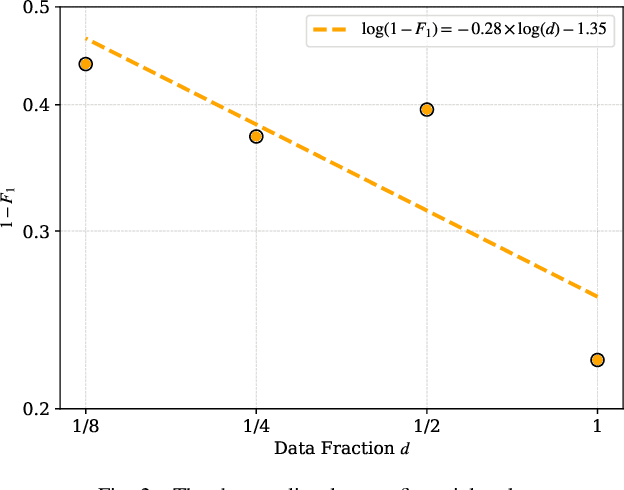

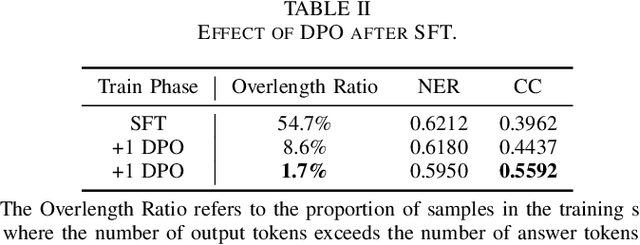
Abstract:This paper investigates the application of large language models (LLMs) to financial tasks. We fine-tuned foundation models using the Open FinLLM Leaderboard as a benchmark. Building on Qwen2.5 and Deepseek-R1, we employed techniques including supervised fine-tuning (SFT), direct preference optimization (DPO), and reinforcement learning (RL) to enhance their financial capabilities. The fine-tuned models demonstrated substantial performance gains across a wide range of financial tasks. Moreover, we measured the data scaling law in the financial domain. Our work demonstrates the potential of large language models (LLMs) in financial applications.
From Equations to Insights: Unraveling Symbolic Structures in PDEs with LLMs
Mar 13, 2025Abstract:Motivated by the remarkable success of artificial intelligence (AI) across diverse fields, the application of AI to solve scientific problems-often formulated as partial differential equations (PDEs)-has garnered increasing attention. While most existing research concentrates on theoretical properties (such as well-posedness, regularity, and continuity) of the solutions, alongside direct AI-driven methods for solving PDEs, the challenge of uncovering symbolic relationships within these equations remains largely unexplored. In this paper, we propose leveraging large language models (LLMs) to learn such symbolic relationships. Our results demonstrate that LLMs can effectively predict the operators involved in PDE solutions by utilizing the symbolic information in the PDEs. Furthermore, we show that discovering these symbolic relationships can substantially improve both the efficiency and accuracy of the finite expression method for finding analytical approximation of PDE solutions, delivering a fully interpretable solution pipeline. This work opens new avenues for understanding the symbolic structure of scientific problems and advancing their solution processes.
Parsing the Language of Expression: Enhancing Symbolic Regression with Domain-Aware Symbolic Priors
Mar 12, 2025



Abstract:Symbolic regression is essential for deriving interpretable expressions that elucidate complex phenomena by exposing the underlying mathematical and physical relationships in data. In this paper, we present an advanced symbolic regression method that integrates symbol priors from diverse scientific domains - including physics, biology, chemistry, and engineering - into the regression process. By systematically analyzing domain-specific expressions, we derive probability distributions of symbols to guide expression generation. We propose novel tree-structured recurrent neural networks (RNNs) that leverage these symbol priors, enabling domain knowledge to steer the learning process. Additionally, we introduce a hierarchical tree structure for representing expressions, where unary and binary operators are organized to facilitate more efficient learning. To further accelerate training, we compile characteristic expression blocks from each domain and include them in the operator dictionary, providing relevant building blocks. Experimental results demonstrate that leveraging symbol priors significantly enhances the performance of symbolic regression, resulting in faster convergence and higher accuracy.
Curse of Dimensionality in Neural Network Optimization
Feb 07, 2025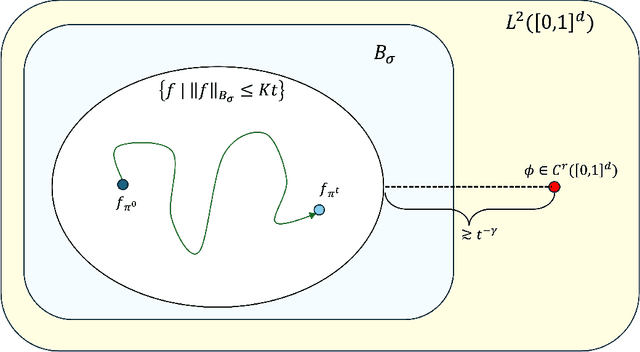
Abstract:The curse of dimensionality in neural network optimization under the mean-field regime is studied. It is demonstrated that when a shallow neural network with a Lipschitz continuous activation function is trained using either empirical or population risk to approximate a target function that is $r$ times continuously differentiable on $[0,1]^d$, the population risk may not decay at a rate faster than $t^{-\frac{4r}{d-2r}}$, where $t$ is an analog of the total number of optimization iterations. This result highlights the presence of the curse of dimensionality in the optimization computation required to achieve a desired accuracy. Instead of analyzing parameter evolution directly, the training dynamics are examined through the evolution of the parameter distribution under the 2-Wasserstein gradient flow. Furthermore, it is established that the curse of dimensionality persists when a locally Lipschitz continuous activation function is employed, where the Lipschitz constant in $[-x,x]$ is bounded by $O(x^\delta)$ for any $x \in \mathbb{R}$. In this scenario, the population risk is shown to decay at a rate no faster than $t^{-\frac{(4+2\delta)r}{d-2r}}$. To the best of our knowledge, this work is the first to analyze the impact of function smoothness on the curse of dimensionality in neural network optimization theory.
PINS: Proximal Iterations with Sparse Newton and Sinkhorn for Optimal Transport
Feb 06, 2025



Abstract:Optimal transport (OT) is a critical problem in optimization and machine learning, where accuracy and efficiency are paramount. Although entropic regularization and the Sinkhorn algorithm improve scalability, they frequently encounter numerical instability and slow convergence, especially when the regularization parameter is small. In this work, we introduce Proximal Iterations with Sparse Newton and Sinkhorn methods (PINS) to efficiently compute highly accurate solutions for large-scale OT problems. A reduced computational complexity through overall sparsity and global convergence are guaranteed by rigorous theoretical analysis. Our approach offers three key advantages: it achieves accuracy comparable to exact solutions, progressively accelerates each iteration for greater efficiency, and enhances robustness by reducing sensitivity to regularization parameters. Extensive experiments confirm these advantages, demonstrating superior performance compared to related methods.
Towards Better Generalization: Weight Decay Induces Low-rank Bias for Neural Networks
Oct 03, 2024Abstract:We study the implicit bias towards low-rank weight matrices when training neural networks (NN) with Weight Decay (WD). We prove that when a ReLU NN is sufficiently trained with Stochastic Gradient Descent (SGD) and WD, its weight matrix is approximately a rank-two matrix. Empirically, we demonstrate that WD is a necessary condition for inducing this low-rank bias across both regression and classification tasks. Our work differs from previous studies as our theoretical analysis does not rely on common assumptions regarding the training data distribution, optimality of weight matrices, or specific training procedures. Furthermore, by leveraging the low-rank bias, we derive improved generalization error bounds and provide numerical evidence showing that better generalization can be achieved. Thus, our work offers both theoretical and empirical insights into the strong generalization performance of SGD when combined with WD.
Solving High-Dimensional Partial Integral Differential Equations: The Finite Expression Method
Oct 01, 2024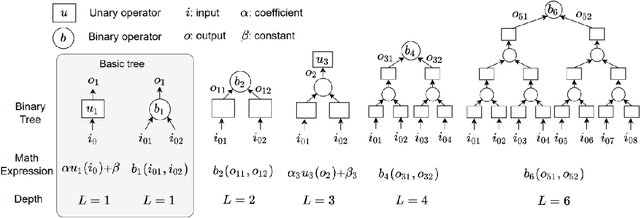

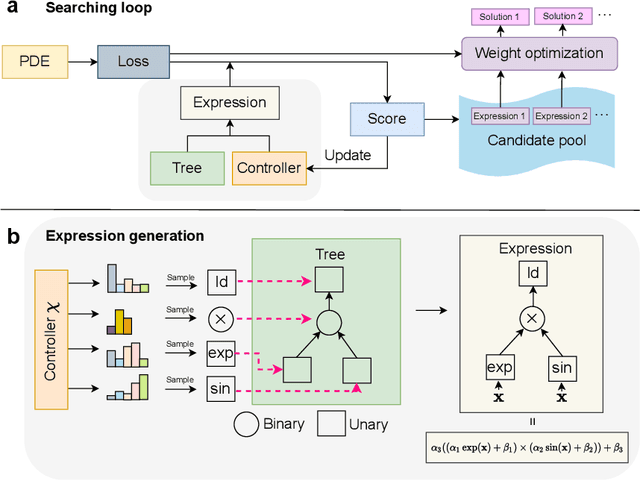

Abstract:In this paper, we introduce a new finite expression method (FEX) to solve high-dimensional partial integro-differential equations (PIDEs). This approach builds upon the original FEX and its inherent advantages with new advances: 1) A novel method of parameter grouping is proposed to reduce the number of coefficients in high-dimensional function approximation; 2) A Taylor series approximation method is implemented to significantly improve the computational efficiency and accuracy of the evaluation of the integral terms of PIDEs. The new FEX based method, denoted FEX-PG to indicate the addition of the parameter grouping (PG) step to the algorithm, provides both high accuracy and interpretable numerical solutions, with the outcome being an explicit equation that facilitates intuitive understanding of the underlying solution structures. These features are often absent in traditional methods, such as finite element methods (FEM) and finite difference methods, as well as in deep learning-based approaches. To benchmark our method against recent advances, we apply the new FEX-PG to solve benchmark PIDEs in the literature. In high-dimensional settings, FEX-PG exhibits strong and robust performance, achieving relative errors on the order of single precision machine epsilon.
 Add to Chrome
Add to Chrome Add to Firefox
Add to Firefox Add to Edge
Add to Edge